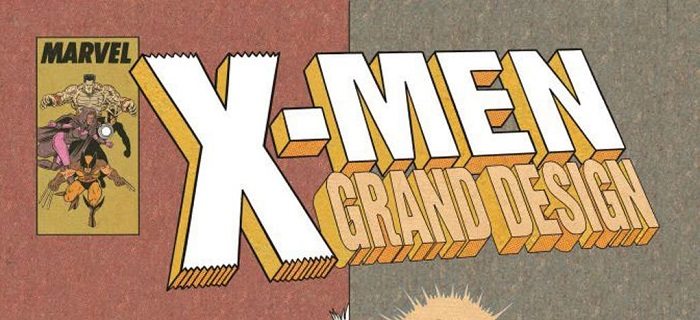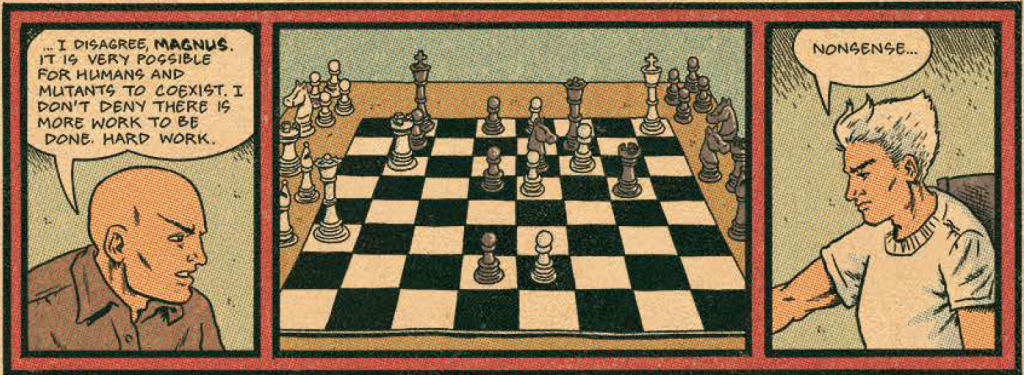The first 30 years of the X-Men, including Chris Claremont’s record-setting run, is legendary. With almost two decades and 200 issues within Claremont’s tapestry alone, it’s hard to imagine how all of that could be condensed into a mere six books. For someone to even think of doing so, they would have to be either extremely confident in their own abilities or more than a little bit arrogant.
Auteur cartoonist Ed Piskor freely admits to the latter and has a portfolio and Eisner Award to back up the former. That’s why, riding on the high of his 2015 Eisner win for Best Reality-Based Work, Piskor issued a tweet demanding that Marvel let him create something for the publishing company. About an hour later, he had a reply from former Editor-in-Chief, Axel Alonso, and soon after, they had hammered out a deal for X-Men: Grand Design, 240 pages of X-Men history.
“I wanted 300 pages,” said Piskor in a phone interview last month, but Marvel talked him down to the six issues, with the first issue releasing on December 20th, followed closely by #2 in January. The three two-part miniseries will consist of X-Men: Grand Design, X-Men: Grand Design – Second Genesis, and X-Men: Grand Design – X-Tinction. These will subsequently be collected into one oversized trade paperback.
Piskor has worked with Marvel before on the New Avengers #1 and All-New X-Men #1 hip-hop variant covers. Evidently that, plus the cartoonist’s critically acclaimed work on Hip Hop Family Tree and Wizzywig, was enough for Alonso to leave the amateur pop culture historian to write, draw, ink, letter, and color the entire project. Otherwise, Marvel didn’t offer any further support in terms of source material or editorial input.
That’s either a lot of faith on Marvel’s part or a lack of concern over a comic mythology that is very precious to many fans, particularly Claremont fans like myself, who grew up with the X-Men. Taking a break from drawing Dr. Doom being zapped by electricity on page seven of issue four, Piskor explained that he’s one of those fans, and he’s been drawing these characters since he was an “inept 12-year-old.” Issue #157 came out just before he was born. His earliest memories involve stacks of comics.
“My dad tried to raise me as a good old American boy with baseball and comic books and the little red wagon–all the little things a little kid should have in a Normal Rockwell painting.”
As a young teenager, he would get his monthly fix of Classic and Uncanny X-Men until shortly after Claremont left the book. Piskor describes Claremont’s replacement, Fabian Nicieza’s writing, as the methadone that weaned him off of the X-Men. After following X-artists like Jim Lee and Marc Silvestri over to Image Comics, Piskor soon edged into books from Fantagraphix (who would eventually publish his Hip Hop Family Tree) to fill the gap. He discovered manga, including Goodnight Punpun by Inio Asano, whose aesthetic and storytelling approach changed Piskor’s own approach to comics. Because, throughout all of this, Piskor never stopped drawing his own comics and gathering information.
“My space is a comics-making factory,” he explains, rattling off the numbers of long boxes and stacked shelves that surround him. There are a classroom-sized blackboard and bulletin boards on the walls with strings connecting obscure notes. And if he doesn’t have the book he needs for reference, he’s got a local Pittsburgh comic store that lets him rummage through Marvel issues dating all the way back to 1939. Convenient, since, as noted, Marvel didn’t offer any resources for this particular project.
“I guess they live in the Marvel world and assume everyone has everything,” Piskor mused, noting that he hadn’t thought to ask anyway, since he already has so much information at his fingertips and finds pleasure in hunting for more. He considers himself to be “a monastic student of the comics form.” Poring over source material and doing the homework “has become an integral part of my comics making process.”

Fortunately, by the time I got on the phone with him, I’d read the first issue of his grand design, as well as an interview detailing his dedication to creating works based on his passions. Both served to temper my indignant wrath over the audacity of a six-issue condensation of X-history. Walking into the first issue, I could not fathom how he could possibly compress so much story and character development and nuance into so few pages, but turns out, with a lot of diligence, research, and, he says solemnly, sensitivity and respect for the readers who feel strongly about the original stories, he may well have managed it with Grand Design.
“I’m not going to your house and burning down your old X-Men collection,” he promises. Plus, he got the official nod from Claremont himself. “I had the opportunity to talk to him all day at his house after NYCC.” Among other things, the topic of Classic X-Men came up, where Claremont explained stories like “Tag, You’re It” in issue #10 where Logan is stalked and killed every year on his birthday by Sabretooth. Piskor told Claremont that there were some confusing elements of the history that he’d have to finesse to make work, which Claremont firmly agreed was the right thing to do with the editorial “clusterfucks” that Claremont had had to deal with at the time, such as bringing Scott Summers back from retirement.
“It was magnanimous of him to give me the leeway,” Piskor says, though he fully acknowledges that, while his project is based on canon, such finessed elements make this essentially an elaborate work of fanfiction. “I’m taking the stuff I really like,” he says. “I had to change and massage some of the stuff that I really hated to get it to work.”
The changes may be enough to infuriate a diehard fan, but personally speaking, I’m okay with a few choice adjustments, as long as the story and characters hold true overall. Despite the limited space, Piskor does manage to get across the minute details that shape the personalities and relationships of these characters and the gray area that surrounds all of them, despite being created during a time when characters were either blatantly good or evil. There are enough Easter eggs and details to keep an X-fan interested. “It’s my own version of Marvels. At any opportunity, I’m going to inject some fun factoid of Marvel history,” such as an epic battle with Namor from a comic from 1941 that he uses as “a tangible example of how mutants are considered a threat instead of just the aesthetic differences.”
Meanwhile, and perhaps, more importantly, the Grand Design series will give a new reader a place to start. “My interest has always been in bringing new readers to the game,” says Piskor. “I think we can all agree that it’s a big history and some of us were pretty privileged to have had the chance to read all that stuff from the beginning.”
Now, it’s far more difficult to suggest a starting point for an entry level X-Men fan who might be stepping into the comics from the movies or cartoons. The first issue sweeps through Charles Xavier and Eric Lensherr’s young lives and the situations that shape them and eventually bring them together as friends and enemies. In a similar style as Hip Hop Family Tree, Grand Design features tight panels and narrative exposition that makes the most out of the limited space. “I have to use the page for all its worth. That’s where captions come in,” in order to capture specific moments in time.
“I feel like I can detect the creator’s enthusiasm in what they are doing,” he says of some of the works he admires. The same can be said about his animated chatter as he explains his processes and his desire to make comics for the rest of his life. “I got into comics to make comics. I would like to have a hit so I could go full Salinger and get off the internet and just keep doing what I love.”
Though he never expected to be working on such a grandiose project for one of the Big 2, it serves as another step in his continual evolution as a comic creator.
“It’s a running joke with my friends that I’m satisfied knowing that I’m going to eventually die unsatisfied. I don’t want to relax; this is my default setting. I expect to just keep getting better and better. I don’t have the most confidence in my work, so that allows me the opportunity to be hard on myself and not get precious about my work.”
Piskor hopes that his work will incentivize Marvel and DC to give more work to auteur artists.
“Put Kate Beaton on Fantastic Four,” he suggests. “Let’s see what that looks like.”
Where Piskor lacks confidence is in the business of selling comics. “The beauty of comics is that you can take a look at something and know whether or not you want to buy it. My secret fantasy is that people will completely dig it.” Hopefully, this is where Marvel will lend some support for the project in order to ensure its success.
Issue one of X-Men: Grand Design will be in stores on December 20th, just in time for Christmas.




